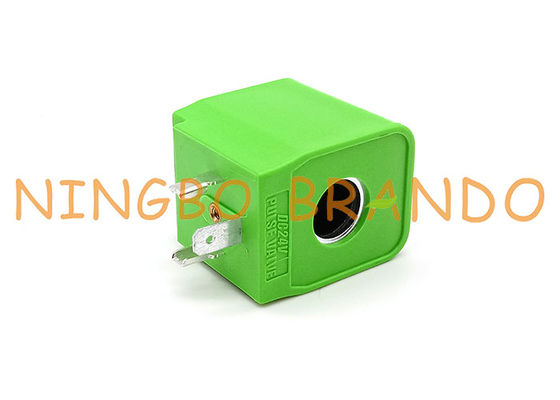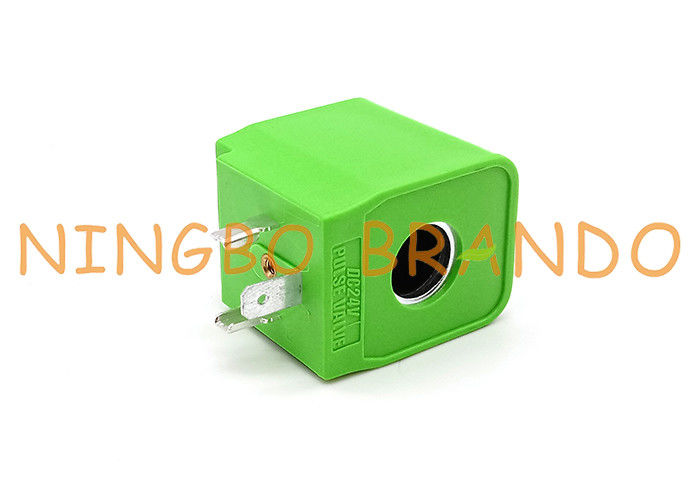BFEC DMF Series New Version Dust Collector Pulse Jet Valve Electrical Coil
Solenoid working principles
Solenoids are the most important components used in solenoid valves to control the flow of liquids and gases. Solenoids are electromechanical devices that convert AC or DC electrical energy into linear motion. They usually consist of a helical coil wound concentrically around a movable cylinder, called the armature, made from a ferromagnetic material such as iron or steel. Most solenoid valves have a replaceable coil and can be used with coils with different voltages.
When current flows through the coil, it generates a magnetic field inside the coil which attracts the armature towards the center of the solenoid using the same basic principles as ordinary electromagnets. Since the armature is drawn towards the center of the solenoid regardless of the polarity of the current, an opposing force is needed to return the armature into the starting position when the coil is not energized. This is achieved by using a spring mechanism. Under ideal conditions, in order to actuate the solenoid, the force generated by the solenoid must be larger than the combined forces of the spring, and the hydraulic pressure, as well as friction.
First, the solenoid coil connection method:
1. Lead type: The electromagnetic coil lead type connection method can be divided into electric wires, two-core cables and three-core cables.
2. Pin type: pin type can be divided into three plugs (DIN43650A, DIN43650B, DIN43650C, or customized), two plug or custom-made form.
Second, the insulation level of the solenoid coil:
1. Insulation material grade: 130 (B) Temperature rise ≤ 85 ° C
2. Insulation material grade: 155 (F) temperature rise ≤ 115 ° C
3. Insulation material grade: 180 (H) temperature rise ≤ 140 ° C
4. Insulation material grade: 200 (N) temperature rise ≤ 160 ° C
Technical parameter of pulse solenoid jet valve coils:
| Model Number |
BB13541204 |
| Normal voltage |
AC220V/AC110V; DC24V/DC12V |
| Normal power |
20W - 30W |
| Insulation class |
B, F, H |
| Connection type |
DIN43650 |
| Application |
Pulse Valve Automatic Control |
| Weight |
71.5 g |
| Operating temp |
-20 - +40℃ |
| Protection class |
IP65 |
| Duty cycle |
20% (Intermittent work) |
Main dimension of 13mm hole size pulse jet valve spare part coils:

Old and new two type Copper & Plastic pulse solenoid coils for you to choose:

Coil winding machine of DC24V/220VAC automatic control pulse valve coils:

How to improve the Q value of the wound solenoid coil?
The quality factor Q is a weight parameter that reflects the quality of the coil. Increasing the Q value of the coil is one of the important points that must be paid attention to when winding the electromagnetic coil. So, how to improve the Q value of the electromagnetic coil? Let me introduce you in detail below.
According to the working frequency, the wire of the coil is selected. Inductors with short working and low frequency are usually fired with insulated wires such as enameled wires. The operating frequency is higher than tens of thousands of Hz, and in the circuit below 2MHz, the multi-strand insulated wire is used to wind the electromagnetic coil, which can effectively increase the surface area of the conductor, so that the Q value is higher than the coil wound by the single wire of the same cross-sectional area. About 30%.
Use a high quality coil bobbin to reduce media loss. In high frequency applications, such as short-wavelength bands, due to the common coil bobbin, the dielectric loss is high. Therefore, high-frequency dielectric materials such as high-frequency ceramics, polytetrafluoroethylene, polystyrene, etc. should be used as the skeleton, and Winding is performed by the winding method.
Choose a reasonable coil size to reduce damage. When the winding thickness t, the winding length L, and the outer diameter D satisfy 3t + 2L = D, the loss is also the smallest. The coil with the shield is optimal when L/D = 0.8-1.2.
Select the diameter of a reasonable shield. Using a shield can increase the damage of the solenoid and reduce the Q value. Therefore, the size of the shield should not be too small. If the area of the shield is too large, the volume will increase.
Welcome to your inquiry!

 Your message must be between 20-3,000 characters!
Your message must be between 20-3,000 characters! Please check your E-mail!
Please check your E-mail!  Your message must be between 20-3,000 characters!
Your message must be between 20-3,000 characters! Please check your E-mail!
Please check your E-mail! 


